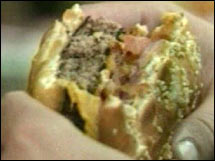The fast-food capital of AmericaAn annual report tracks which U.S. cities have the greatest percentage of 'heavy users' of fast food. Oklahoma City has the dubious distinction of consistently topping the list, says Fortune's Matthew Boyle.NEW YORK (Fortune) -- In April of 1889, ambitious homesteaders sprinted to grab the best tracts of land in what became the state of Oklahoma, with some 10,000 of them settling in what is now downtown Oklahoma City almost overnight. Good luck getting the city's denizens to re-create that famous run today.  Over the past several years, Oklahoma City has consistently been home to more so-called "heavy users" of fast food than any other American city, according to data compiled by Sandelman & Associates, a San Clemente, Calif.-based market research firm that tracks consumer trends for the $537 billion restaurant industry. While Greenville, North Carolina earned the dubious honor as the No. 1 market for heavy users in 2006, with 59 percent of its fast-food patrons grabbing burgers and fries 12 or more times a month - versus a national average of 42 percent - only Oklahoma City made the top ten list in the years 1999, 2003 and 2006. (Heavy users, usually young men, are defined as those who visit a fast-food restaurant at least 12 times a month.) "We're always excited to be in the top ten of things, but not this," says Christine Berney, a spokeswoman for the Greater Oklahoma City Chamber. Last year, well over half (55 percent) of Oklahoma City fast-food patrons dined in establishments like McDonald's (Charts) or Wendy's (Charts) a dozen times or more per month, placing it tied for No. 3 with Memphis and Charleston/Huntington, West Virginia. A similar percentage of Oklahoma City residents earned "heavy user" status in 2003, while in 1999 that figure was 47 percent, still well above the national average of 38 percent at the time. When ranked by the number of trips, fast-food users in McAllen, Texas, led the nation last year with 25 monthly visits per person, on average - yes, that's almost once every day - but Oklahoma City was right behind with 21. Three other Texas cities - El Paso, San Antonio and Dallas - also made the top ten. None of the leading fast-food gobbling cities is north of the Mason-Dixon line, Sandelman reported. What's behind Oklahoma City's propensity to purchase Big Macs? For starters, Oklahoma City ranked No. 15 in the latest survey of "America's Fattest Cities" by Men's Fitness magazine, which based its results on things like gym memberships and the amount of time spent sitting in traffic. That's up from No. 17 last year, but this is not a list you want to move up on. The city also houses the headquarters of fast food chain Sonic (Charts), which has 268 locations across the state. (By comparison, Sonic has only 34 restaurants in all of California.) A quick search of McDonald's locations in the Oklahoma City area turned up 50 Golden Arches in and around the city, so its residents are certainly not wanting for fast-food options. Nor is McDonald's wanting for profitable customers: Its stock has quadrupled since 2003 and is currently trading right near its 52-week high of $46.74. Sonic has also been on a tear recently, receiving an upgrade from J.P. Morgan analyst Steven Rees late last month. Finally, the median household income in Oklahoma City is $34,947, low for a city of its size, with a population of just over half a million, according to Census data. By comparison, Portland, Oregon, with a similar population, has a median household income of $40,146. Perhaps not coincidentally, Portland's residents are among the least frequent patrons of fast-food establishments in the nation, along with Anchorage, Boston and Portland, Maine. Quick-service diners in those cities average fewer than 13 visits a month, well under the national average of 17 visits, Sandelman found. To its credit, Oklahoma City is trying to whip itself into better shape - about 18 months ago Mayor Mick Cornett launched the "Mayor's Fitness Challenge" along with his counterpart in Tulsa, and Cornett's office has also distributed 100 pedometers to city employees to encourage them to walk more. And Oklahoma City is of course not alone in its insatiable appetite for fatty burgers, salty fries and sugary soft drinks. Nationwide, on average, fast-food patrons have upped their monthly visits from 14 in 1999 to 17 last year. While the restaurant industry vehemently discounts any link between fast food consumption and rising obesity rates, it's worth noting that researchers at the nonprofit Rand Corporation recently found that the proportion of Americans with a body-mass index of 30 or more increased by 24 percent between 2000 and 2005. (Body mass index is calculated by dividing weight in kilograms by the square of a person's height in meters. An adult who has a BMI of 30 or higher is considered obese.) According to the Centers for Disease Control and Prevention, Oklahoma was one of 17 states that had an obesity prevalence rate of 25 percent or higher in 2005. Back in 1990, no state had a rate at or above 20 percent. |
Sponsors
|
